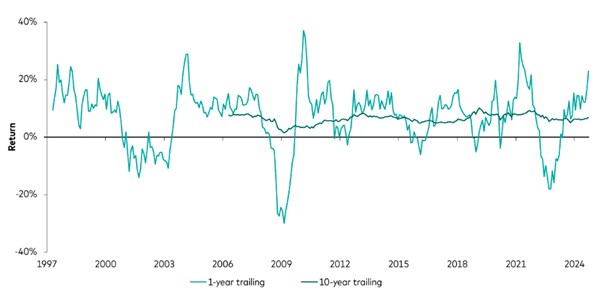17 February 2025
What does the current state of the bond market mean for the traditional 60/40 split?
;)
Investing your hard-earned wealth requires a juggling act of potential growth versus managing risk.
You’ll need to think about your risk profile, and your capacity for loss, and keep an eye on your asset allocation. The latter might include the bonds you hold.
These are essentially loans to governments or companies that offer a fixed interest rate – known as a “coupon” – over a set period. At the end of the bond’s term, you typically receive your initial investment back, plus interest.
In the UK, government bonds, or “gilts”, have seen notable increases in yields. Indeed, Morningstar reports that the 30-year gilt yield recently reached its highest level since the late 1990s, while the 10-year gilt yield reached levels last seen in 2008.
Continue reading to discover why bond yields have risen, their potential role in your portfolio, and how they fit into the so-called “60/40” split.
3 potential benefits of investing in bonds
The bond market has seen some volatility in recent months. Bond yields typically move in the same direction as interest rates and inversely to bond prices. When interest rates are high, bond yields generally rise, while prices fall. Inflation cooled in 2024, but the decline was slower than many investors anticipated. This prompted the Bank of England (BoE) to keep interest rates higher for longer. And then came the Autumn Budget, which further spooked the market.
As with any form of investing, though, it’s important to look long term and to remember the important role government bonds can play in a diversified and risk-managed portfolio.
1. They are generally seen as low-risk investments
A bond’s perceived safety is largely due to the stability of the issuing government or company. For instance, UK gilts are often seen as “safer” than bonds from less stable nations, as the UK government has a strong track record of meeting its debt obligations.
In fact, the Debt Management Office reveals that the UK government has never missed an interest payment on gilts, potentially making them a reliable choice if you’re a risk-averse investor.
2. They pay regular interest
Bonds offer a fixed interest payment, providing a predictable income stream. This could be especially appealing if you’re seeking a passive income through investing, perhaps in retirement.
If you’re more focused on growth, you could reinvest coupons to boost your returns over time.
However, it’s vital to remember that investing means balancing risk and reward. Since bonds are considered lower risk, the returns may be lower too.
3. They allow you to diversify your portfolio
Diversification is a cornerstone of sound investment. By spreading your investments across various sectors, asset classes, and geographical areas, you could reduce risk and boost your long-term financial stability.
During periods of market downturn, you may find that bonds offer stability, potentially offsetting losses elsewhere. This could also help you avoid making emotion-led decisions during turbulent times.
The “60/40” split could allow you to adequately diversify your portfolio
A “60/40” portfolio allocates 60% of your invested funds to shares and 40% to bonds. It’s based on the idea that diversifying your investments can reduce risk and increase long-term returns.
Historically, this approach has provided consistent long-term gains. The Vanguard chart below illustrates how the 60/40 portfolio has performed over time.

Source: Vanguard
As you can see, the strategy has seen its good and bad years, with 2022 being among the worst. Still, though, 10-year returns have been far more stable.
Now, with bond yields rising, the 60/40 strategy could become appealing once again. Higher yields mean bonds may offer more competitive returns than they have in recent years, which is good news for your well-diversified portfolio.
While the 60/40 split might be “back” according to some experts, it’s vital to tailor your investment strategy to your circumstances. The right balance will depend on factors such as your risk tolerance, goals, and investment time frame.
Speak to a professional
If you’re still unsure whether bonds or the 60/40 split aligns with your goals, speak to us. We can assess your risk profile and create a tailored strategy that aligns with your long-term objectives.
Be sure to contact us now to find out how our Chartered financial planners can help.
Please note
This article is for general information only and does not constitute advice. The information is aimed at retail clients only.
Please do not act based on anything you might read in this article. All contents are based on our understanding of HMRC legislation, which is subject to change.
The value of your investments (and any income from them) can go down as well as up and you may not get back the full amount you invested. Past performance is not a reliable indicator of future performance. Investments should be considered over the longer term and should fit in with your overall attitude to risk and financial circumstances.
Category: News
